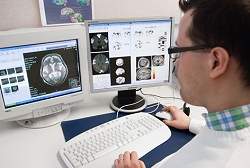Diagnóstico precoce de Alzheimer
O diagnóstico do Mal de Alzheimerrequer uma visão holística do paciente, combinando informações de várias fontes, tais como ensaios clínicos, neuroimagens e amostras de sangue.
A conclusão é do PredictAD - Predição da Doença de Alzheimer - um projeto de pesquisas internacional financiado pela União Europeia, que está desenvolvendo métodos objetivos e eficientes para permitir um diagnóstico mais precoce da doença de Alzheimer.
"O objetivo do projeto PredictAD é desenvolver um indicador objetivo para diagnosticar a doença de Alzheimer o mais cedo possível.
"As atuais diretrizes de diagnóstico enfatizam a importância de diversos biomarcadores. Desenvolvemos novas abordagens para extrair biomarcadoresde dados de imagens, dados eletrofisiológicos e amostras de sangue, e um software exclusivo e clinicamente útil para a integração de todas essas medições heterogêneas," explica o coordenador científico do projeto, Dr. Jyrki Lotjonen, do Centro Técnico de Pesquisas VTT, na Finlândia.
Ressonância magnética para a identificação de atrofia
A atrofia do lobo mediotemporal é uma marca bem conhecida da doença de Alzheimer.
As imagens por ressonância magnética representam um excelente instrumento para medir essa perda de tecido.
Na prática clínica atual, as imagens são interpretadas na sua maioria apenas por inspeção visual, mas há uma grande necessidade de medidas objetivas.
Os cientistas desenvolveram vários métodos para atender a essa necessidade.
"Conseguimos desenvolver ferramentas eficientes para medir o tamanho do hipocampo, a taxa de atrofia do hipocampo, e duas abordagens modernas baseadas na comparação dos dados do paciente com casos previamente diagnosticados, disponíveis em grandes bases de dados," explica o professor Daniel Rueckert, do Imperial College de Londres.
A tomografia por emissão de pósitrons (PET) é outra tecnologia de imagem estudada no projeto. Um novo rastreador desenvolvido especialmente para o diagnóstico da doença de Alzheimer está fornecendo resultados promissores para o diagnóstico precoce da doença.
Detectar mudanças na eletrofisiologia do cérebro
A doença de Alzheimer é conhecida por afetar a atividade eletromagnética do cérebro.
Durante o projeto, os cientistas estudaram o desempenho de uma nova tecnologia, a estimulação magnética transcraniana (TMS), combinada com eletroencefalograma (EEG).
A força da combinação TMS/EEG é que ela permite uma verificação direta e não-invasiva do córtex cerebral humano sem a necessidade de colaboração do paciente.
O estudo mostrou alterações significativas em pacientes de Alzheimer em comparação com pessoas com envelhecimento saudável.
Técnicas não-invasivas para encontrar biomarcadores de Alzheimer
Biomarcadores moleculares estão atualmente em estudos aprofundados na investigação da doença de Alzheimer.
Muitos biomarcadores, tais como proteínas tau e b-amiloide 42, medidos a partir do líquido cefalorraquidiano, o líquido que envolve o córtex cerebral, estão fortemente relacionados com a doença.
Um dos maiores desafios desses biomarcadores é que a coleta de amostras de líquido cefalorraquidiano é uma medida invasiva, o que limita a sua utilização no diagnóstico precoce.
Amostras de sangue seriam uma excelente fonte para detectar a doença de Alzheimer, já que a coleta de sangue não é considerada uma técnica invasiva.
Embora sem resultados definitivos, os pesquisadores estão estudando o papel dos compostos metabolômicos e protéicos na doença de Alzheimer a partir de amostras de sangue. Os resultados preliminares revelam vários compostos promissores.
Metodologia para avaliar o estado do paciente
Atualmente, os médicos fazem o diagnóstico final de Alzheimer combinando medidas heterogêneas com informações de entrevistas com o paciente e seus familiares.
Este processo envolve uma avaliação subjetiva e exige grande experiência do médico.
Os hospitais modernos, por sua vez, têm enormes bases de dados contendo "informações ocultas" que podem ser utilizadas no diagnóstico por meio de uma modelagem matemática sistemática.
Os especialistas do PredictAD idealizaram uma abordagem totalmente nova para medir objetivamente o estado do paciente.
Este sistema de apoio à decisão, desenvolvido em estreita colaboração com os clínicos, compara as medidas de cada paciente com medições de outros pacientes em grandes bases de dados, fornecendo ao final um índice e uma representação gráfica refletindo o estado do paciente.
"A ferramenta PredictAD é uma nova opção para apoiar a tomada de decisões," diz o prof. Hilkka Soininen, da Universidade da Finlândia Oriental, que está fazendo a validação clínica do projeto.
Melhores práticas
Os resultados preliminares do PredictAD foram apresentados em um seminário em Kuopio, na Finlândia, em Junho.
O objetivo do simpósio era apresentar e discutir os resultados do projeto e as mais recentes inovações para o diagnóstico precoce da doença de Alzheimer com especialistas de todo o mundo, que agora poderão incorporar as novas práticas e fundamentar novos estudos.






